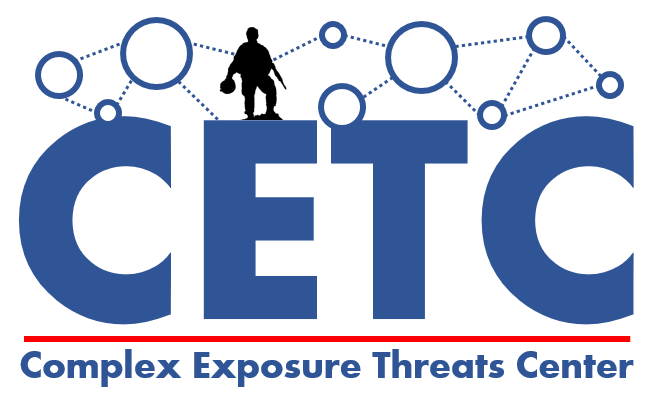War Related Illness and Injury Study Center
Research
Complex Exposure Threats Center (CETC)

CETC provides a framework to integrate with clinical information and knowledge across multiple sources by leveraging a close synergy between three research cores: Exposure Science, Clinical Research, and Computational Modeling and Data Integration. These cores are designed to develop a new understanding of how complex occupational and environmental hazards impact Veteran health.
Exposure Science Research Core
This research core focuses on exposure metrics, assessment, and monitoring to advance our understanding of occupational or environmental hazards and how they may adversely impact the health of Veterans. Evidence-based research linking injury, disease, and poor health to occupational and environmental exposures is critical for effective exposure threat detection. This core focuses on the:
-
Development of comprehensive and targeted occupational and environmental tools to better assess Military exposures (e.g., Veteran Military Occupational Exposure Assessment Tool, or VMOAT).
-
Aggregation of data sources to better understand the nature of the complex injuries and illnesses, and to establish links between available health information and documented occupational and environmental exposure data.
-
Assesses wearable technologies designed to monitor occupational and/or environmental conditions and the corresponding physiological responses for relevance to VA health care.
Clinical Research Core
This core establishes common data elements for exposure cohorts by creating research pipelines to investigate associations between exposure dose and physiological loss of function. This framework further allows for research innovation through investigator-driven microgrants that will help recruit new scientists and expertise focused on emerging exposure threat topics and provide opportunities for deeper investigations within clinical translational research. This core focuses on:
-
Medical record reviews with detailed exposure histories and longitudinal monitoring of biobehavioral symptoms.
-
Application of an allostatic load model to evaluate physiological loss of function and symptom severity measurements that are linked to available exposure dose estimates.
-
Deep phenotyping descriptions of clinical symptoms for select Veteran cohorts.
Computational Modeling and Data Integration Research Core
This research core will use computational tools to support the integration and translation of available knowledge connected to the exposures of interest. Application of advanced text-mining, and quantitative and semi-qualitative models help to capture information from scientific literature reviews, clinical insights, and other relevant data sources. This core also offers a consistent exposure modeling framework for integrating an expansive scope of available knowledge and data to identify novel relationships between military exposures, symptoms, physiologic mechanisms, and clinical outcomes. Specifically, this core will focus on:
-
Application of model-based knowledge graphs, data integration, and simulation of anticipated exposure effects and health outcomes.
-
Model-based predictions or simulation-based development of precision-medicine interventions for at-risk and exposed populations.
-
Data integration with knowledge models to develop diagnostic tools, establish exposure or disease mechanism, identify potential early disease biomarkers of exposure, or study unexplained exposures and their likely health effects or characteristic symptoms.



















